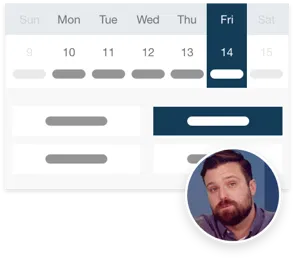Leasing is at the heart of a thriving residential property management business. Whether you’re handling a cozy multi-family building or a sprawling apartment complex, getting your leasing process down to a science can result in high occupancy, more consistent revenue, and better long-term relationships with tenants.
In this post, we’ll dive into every aspect of the leasing process, from selecting the right tenants to drafting rock-solid lease agreements. We’ll also cover how to keep tenants happy and engaged, as well as strategies to keep your leasing game strong. Let’s walk through the challenges property managers face and the best ways to tackle them head-on.
How Tenant Screening Fits into Property Management Leasing
When it comes to leasing, your tenant selection process is the first line of defense. A well-thought-out screening process helps you find responsible tenants who will take care of your property and pay their rent on time consistently. Here’s what you need to focus on:
- Background Checks: Always run criminal background checks to protect your property and your community. This step helps you avoid tenants who may have a history of illegal activity or disruptive behavior.
- Credit Scores: A potential tenant’s credit score often tells you how reliably they handle financial obligations. While it’s not the only factor, a score of 650 or higher typically indicates a good chance that they will pay their rent on time. Keep in mind, though, that each property and situation is unique.
- Rental History: Check with previous landlords to get a sense of how responsible tenants are when it comes to paying rent and keeping their living spaces in good shape. A tenant with a positive rental history is usually a safe bet.
- Employment Verification: Confirm that your tenants have a steady source of income. Reliable employment means they’re more likely to meet their financial commitments.
Watch Out for Red Flags
It’s not always easy to spot a problem tenant, but some signs should raise a red flag:
- Frequent Moves: A history of jumping from place to place may signal instability.
- Negative References: If past landlords mention issues such as late payments or property damage, that’s a warning sign.
- Unverifiable Income: If a tenant can’t provide proof of employment or income, they might struggle to pay rent.
Stay Compliant with Fair Housing Laws
As you review potential tenants, keep Fair Housing Laws in mind. These laws prevent discrimination based on race, religion, national origin, sex, disability, and family status.
You should always review the Fair Housing Act and other relevant laws along with confirming your responsibilities with a legal professional before locking in your tenant screening process. As a general rule, make sure screening is consistent and focused on objective criteria, such as credit score or rental history. This helps avoid legal trouble and promotes a fair selection process for all applicants.
If you want a more detailed rundown on tenant applications and screening, you can read more here.
Drafting Lease Agreements That Make Property Management Leasing Easy
A solid lease agreement protects both you and your tenants. It lays the groundwork for a successful rental experience by clearly outlining everyone’s responsibilities. Here are the key components you should include:
- Rent Terms: Specify the rent amount, due date, and acceptable payment methods. Include details about late fees, grace periods, and what happens if rent isn’t paid on time.
- Security Deposits: Define the amount of the security deposit, conditions for its return, and how damages or unpaid rent will be handled.
- Maintenance Responsibilities: Clearly state who is responsible for what. This includes regular property upkeep such as lawn care, snow removal, and repairs. A clear division of responsibilities helps avoid misunderstandings.
- Pets and Guests: If your property allows pets, outline the rules regarding pet deposits, types of pets allowed, and any restrictions on size or breed. Similarly, be clear about guest policies, including whether tenants can have overnight guests or how long they can stay.
- Termination Conditions: Outline how either party can terminate the lease early. Be sure to specify the required notice period and conditions for ending the lease.
Use Clear, Simple Language
Ambiguous language in lease agreements can lead to confusion or disputes. Avoid terms that leave room for interpretation, such as “reasonable” or “minor” repairs. Instead, get specific about expectations—what exactly constitutes damage, and what repairs fall under tenant responsibility?
Don’t Forget These Key Clauses
While each lease will vary, the following clauses should make an appearance in most:
- Late Payment Clause: Detail any late fees, grace periods, and the actions you’ll take if rent isn’t paid.
- Lease Renewal Terms: Provide options for renewing the lease, along with any changes to rent or terms.
- Insurance Requirements: Some landlords require tenants to have renters’ insurance. Include this in the agreement, so tenants know what’s expected.
Lease Signing and Move-In Process
In property management leasing, signing and move in should be an organized, professional experience. Here’s how to set the stage for a smooth move-in:
- Collect Necessary Documents: Make sure all documents—such as proof of identity, proof of income, and rental history—are in order before the lease signing. This ensures a quick and efficient process.
- Conduct a Walk-Through Inspection: A walk-through inspection helps document the condition of the property. Take photos of any existing damage, so there’s no confusion when the tenant moves out.
- Collect Rent and Deposits: Collect the first month’s rent and security deposit during the lease signing. Make sure the tenant understands how payments will be handled going forward.
Make a Lasting First Impression
Your tenant’s move-in experience sets the tone for the rest of their stay. Keep the process efficient but friendly, offering a warm welcome to make them feel at home. You might even create a welcome package with helpful info such as emergency contacts, property rules, and local amenities.
Tenant Retention and Lease Renewal Strategies for Property Management Leasing
Keeping tenants is often easier than finding new ones. Here’s how to encourage lease renewals and reduce turnover:
- Be Proactive in Communication: Regular check-ins show that you care. Make sure tenants know they can reach out with concerns, and always be responsive when they do.
- Address Maintenance Promptly: If tenants request maintenance, get to it quickly. Fixing problems before they escalate helps keep tenants satisfied and shows you’re on top of things.
- Create a Retention Program: Incentivize lease renewals with perks such as discounted rent for long-term tenants or referral bonuses for bringing in new renters.
Technology to Help with Property Management Leasing
A well-run leasing process is the foundation of a successful property management business. By carefully screening tenants, drafting clear lease agreements, negotiating fair terms, and focusing on tenant satisfaction, you can create an environment where both tenants and property owners thrive. Focus on the bigger picture: the goal is to build strong, long-term relationships that lead to fewer vacancies and more predictable income.
To help you stay proactive and ready to adapt your leasing strategy as needed, consider investing in property management software. Comprehensive platforms such as Buildium include an extensive list of features to help with property management leasing. Here are just a few:
- Rental listing syndication
- Showings coordination
- Online rental application creation, sharing, and signing
- Communication portals and a dedicated mobile app
- Online rent collection
You can test out Buildium for yourself with a free 14-day trial or by scheduling a guided demo.
With the right approach, you’ll have a loyal tenant base, a profitable portfolio, and the peace of mind that comes from knowing you’re on top of your leasing game.
Read more on Leasing
